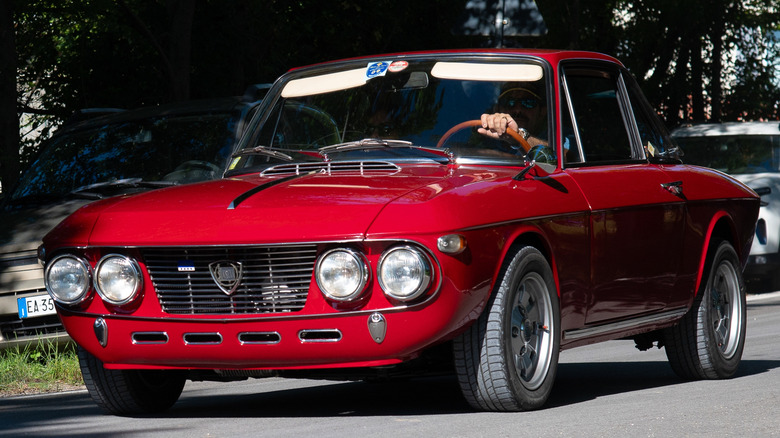V4 engines are few and far between(except in motorcycles). It’s the reverse situation from 8-cylinder engines, where there are scores of V8s and a count-them-on-one-hand amount of flat-8s in automobiles. The Saab 96 was made with a V4, the same engine Ford of Germany used in its Taunus, and those were a good percentage of the V4s ever sold. There was also Ford of Britain’s Essex V4, the Soviet ZAZ V4, and Ford’s Mustang I concept with a V4 that revved to 7,500 rpm. Most manufacturers, if they make non-inline-fours, smash them into flat or boxer configurations. Possibly the most double-take-motivating V4s ever crafted were those produced by Italian automaker Lancia (pronounced LAHN-cha).
Let’s start with a true great: the Fulvia V4. Not only does it send power to the front wheels, but it sits ahead of them, too. That’s just the beginning of the brow-furrowing, mouth-gaping engineering, though. This iron-block, aluminum-everything-else V4 has a stupendously small 12.5-degree “vee” angle, even narrower than Volkswagen’s 15-degree VR6. In contrast to VR6s (until the 24-valve ones, anyway), Fulvia V4s have two camshafts that act like a double overhead setup: one operates exhaust valves and the other handles intake valves, all in a single head casting. Strange, clever, and glorious.
In other weirdness, the Fulvia V4 sits a full 45 degrees tilted to the left. Unlike the Chrysler slant-6, which features a 30-degree tilt, the Fulvia V4 tilts backward just six degrees, and its intake manifold has a twist to keep the carburetors level. Lancia Fulvias turn up for sale online occasionally, but this unique little racer is not a super common sight in the U.S.
Lancia’s V4 engine design dates back over a century
Lancia’s knife-blade thin, V-angled four-cylinder debuted in the 1922 Lambda, which also featured an ahead-of-its-time monocoque chassis (until the company realized people wanted to choose their own coachbuilders). The Lambda’s engine sat bolt upright as opposed to the “tall guy’s head against a low ceiling” angle of the Fulvia V4. Its cylinders were splayed at a relatively tight 20 degrees.
Also in 1922, Lancia introduced its Trikappa V8 with a 14-degree V-angle. Both the Lambda V4 and Trikappa V8 made do with a single camshaft operating two valves per cylinder. The company had even considered a V12, but retaining the narrow angle would have made the engine longer than a banquet table, eliminating the compactness that such a layout exists to furnish. To make things super strange, the Lambda’s combustion chamber was cut into the engine block, spark plugs were threaded directly into it, and the heads were flat.
In case you thought there would be anything normal about Lancia’s V4 legacy, sorry to disappoint. Were you to flatten the engine layout, you would have a Subaru-like boxer engine on your hands because each piston has its own crankpin. Most V engines use shared crankpins for opposing pistons, but it’s better to think of the Lancia V4 as more of a staggering inline-4 than a cut-in-half, traditional two-headed V8. By employing a single head to handle both cylinder banks, the engine was sufficiently weighed down.
Will Lancia rev its V4 engine once more?
Perhaps the pinnacle of Lancia’s V4 efforts was the Fulvia 1.6 HF. If you can look at a red Fulvia coupe and feel nothing, sorry, but you’ve just found out you don’t have a soul. What gave this car the it-factor was a 1.6-liter V4 that pumped out 130 hp in dual-carb form (certain models featured a single downdraft Solex carburetor). The compression ratio was 10.5:1, and it achieved peak power at a decently high 6,200 rpm. Some of the credit for its performance lies within its hemispherical combustion chambers. More pedestrian and older Lancias, such as the Chrysler Airflow-looking Aprilia, also had hemi combustion chambers, which might be the reason these engines seemed to punch above their weight.
Now that Stellantis owns both Chrysler and Lancia, it could bring back the lovely, jewel-like V4 for a racing model like the Lancia Ypsilon Rally HF. If Stellantis puts effort toward any sort of resurrection, Lancia is a deserving candidate. Sure, there’s speculation about a new Delta, but that’s just one of so many cool Lancias that could fuel a second coming.
Lancia was a brilliant, quirky automaker, and the company’s V4 is the best evidence that it deserves better than its current state. Before the Honda Civic R made a front-wheel drive (FWD) layout handle with unshakeable confidence, the Fulvia and its hatchback counterpart, the Zagato Sport, were considered some of the best FWD cars ever made.




